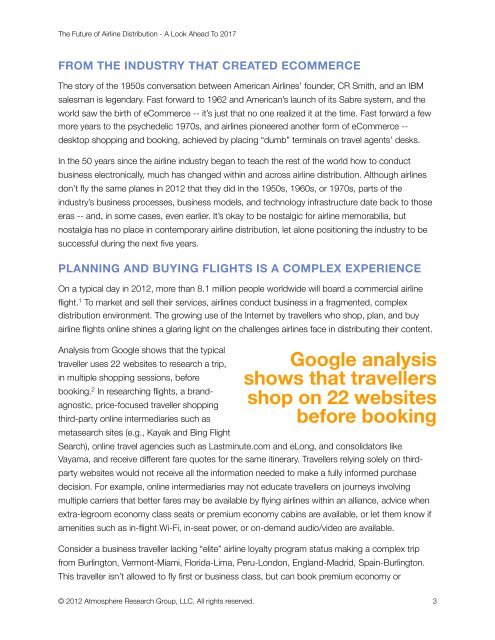The Future Of Airline Distribution - IATA
The Future Of Airline Distribution - IATA
The Future Of Airline Distribution - IATA
Create successful ePaper yourself
Turn your PDF publications into a flip-book with our unique Google optimized e-Paper software.
<strong>The</strong> <strong>Future</strong> of <strong>Airline</strong> <strong>Distribution</strong> - A Look Ahead To 2017<br />
FROM THE INDUSTRY THAT CREATED ECOMMERCE<br />
<strong>The</strong> story of the 1950s conversation between American <strong>Airline</strong>s’ founder, CR Smith, and an IBM<br />
salesman is legendary. Fast forward to 1962 and American’s launch of its Sabre system, and the<br />
world saw the birth of eCommerce -- it’s just that no one realized it at the time. Fast forward a few<br />
more years to the psychedelic 1970s, and airlines pioneered another form of eCommerce --<br />
desktop shopping and booking, achieved by placing “dumb” terminals on travel agents’ desks.<br />
In the 50 years since the airline industry began to teach the rest of the world how to conduct<br />
business electronically, much has changed within and across airline distribution. Although airlines<br />
don’t fly the same planes in 2012 that they did in the 1950s, 1960s, or 1970s, parts of the<br />
industry’s business processes, business models, and technology infrastructure date back to those<br />
eras -- and, in some cases, even earlier. It’s okay to be nostalgic for airline memorabilia, but<br />
nostalgia has no place in contemporary airline distribution, let alone positioning the industry to be<br />
successful during the next five years.<br />
PLANNING AND BUYING FLIGHTS IS A COMPLEX EXPERIENCE<br />
On a typical day in 2012, more than 8.1 million people worldwide will board a commercial airline<br />
flight. 1 To market and sell their services, airlines conduct business in a fragmented, complex<br />
distribution environment. <strong>The</strong> growing use of the Internet by travellers who shop, plan, and buy<br />
airline flights online shines a glaring light on the challenges airlines face in distributing their content.<br />
Analysis from Google shows that the typical<br />
traveller uses 22 websites to research a trip,<br />
in multiple shopping sessions, before<br />
booking. 2 In researching flights, a brand-<br />
agnostic, price-focused traveller shopping<br />
third-party online intermediaries such as<br />
metasearch sites (e.g., Kayak and Bing Flight<br />
Google analysis<br />
shows that travellers<br />
shop on 22 websites<br />
before booking<br />
Search), online travel agencies such as Lastminute.com and eLong, and consolidators like<br />
Vayama, and receive different fare quotes for the same itinerary. Travellers relying solely on third-<br />
party websites would not receive all the information needed to make a fully informed purchase<br />
decision. For example, online intermediaries may not educate travellers on journeys involving<br />
multiple carriers that better fares may be available by flying airlines within an alliance, advice when<br />
extra-legroom economy class seats or premium economy cabins are available, or let them know if<br />
amenities such as in-flight Wi-Fi, in-seat power, or on-demand audio/video are available.<br />
Consider a business traveller lacking “elite” airline loyalty program status making a complex trip<br />
from Burlington, Vermont-Miami, Florida-Lima, Peru-London, England-Madrid, Spain-Burlington.<br />
This traveller isn’t allowed to fly first or business class, but can book premium economy or<br />
© 2012 Atmosphere Research Group, LLC. All rights reserved. 3

















